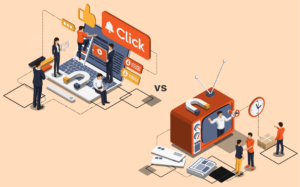
Supercharge Your Digital Marketing: Your Definitive Guide to Mastering the Art and Science of Online Triumph
Are you struggling to figure out how to do digital marketing? With so many different channels and strategies, it can be overwhelming to know where to start. But don’t worry, We are here to help you navigate the world of digital marketing and get your business noticed online.
Digital marketing is crucial for any business in today’s digital age. It’s not just about having a website, but also about creating a strong online presence and engaging with your target audience. In this blog, we’ll walk you through the basics of digital marketing and provide you with actionable tips to help you get started. From social media to email marketing, We’ll cover all the essentials you need to know on how to do digital marketing.
Digital marketing has revolutionized the way businesses connect with their target audience and achieve online success. In this comprehensive guide which can serve as a mini digital marketing course, we will explore the art and science of digital marketing, equipping you with the knowledge and tools to master this ever-evolving field. From laying the foundation to analyzing and optimizing performance, each section will cover essential concepts and digital marketing strategies that can propel your business forward.
Laying the Foundation
The Evolution of Digital Marketing: From Traditional to Online
Over the years, digital marketing has evolved from traditional marketing methods to adapt to the dynamic online landscape. Traditional marketing relied heavily on print, television, and radio, while digital marketing leverages digital channels like search engines, social media, email, and websites. This shift has brought about unparalleled advantages, including increased reach, cost-effectiveness, precise targeting capabilities, and measurable results.
Why Digital Marketing Matters: Key Benefits for Businesses
Digital marketing has become an indispensable aspect for businesses of all sizes. Its ability to reach a wider audience, cost-effectiveness compared to traditional marketing, precise targeting options, and accurate measurement and tracking of results make it an essential tool for success. Businesses can establish their online presence, build brand awareness, engage with their audience, and drive conversions and sales.
Setting Clear Goals: Defining Your Digital Marketing Objectives
Setting clear goals is crucial for a successful digital marketing campaign. By defining specific, measurable, achievable, relevant, and time-bound (SMART) objectives, you can focus your efforts and effectively measure your success. Examples of digital marketing objectives include increasing website traffic, improving search engine rankings, growing social media followers, generating leads, and increasing online sales.
Building Your Digital Presence
Crafting a Powerful Brand Identity: The Key to Successful Digital Marketing
A strong brand identity forms the cornerstone of successful digital marketing. Building a compelling brand involves defining your brand persona, creating a unique value proposition, and developing a consistent visual identity that resonates with your target audience. A strong brand identity helps differentiate your business from competitors, fosters trust and loyalty, and enables effective brand communication across various digital channels.
Creating a User-Friendly Website: Design, Navigation, and Responsiveness
Your website serves as the online face of your business, and its usability and design play a critical role in engaging and converting visitors. A user-friendly website should have an intuitive layout, clear navigation, fast loading times, and responsive design to ensure a seamless experience across different devices. Implementing effective calls-to-action (CTAs) and incorporating user feedback can further enhance the website’s usability and conversion potential.
Optimizing for Search Engines: The Basics of SEO
Search Engine Optimization (SEO) is vital for increasing your online visibility and driving organic traffic. SEO involves optimizing various aspects of your website, including keyword research and implementation, on-page optimization, technical SEO, and building high-quality backlinks. By aligning your website with search engine algorithms and best practices, you can improve your website’s search engine rankings and attract relevant visitors.
Driving Targeted Traffic
Mastering the Art of Content Marketing: Creating Valuable and Engaging Content
Content marketing is a powerful strategy for attracting and engaging your target audience. By creating valuable, relevant, and high-quality content, businesses can establish thought leadership, build trust, and nurture relationships with their audience. Content marketing encompasses various formats, including blog posts, articles, videos, infographics, and podcasts, and should align with your audience’s interests and pain points.
Pay-Per-Click Advertising: Maximizing ROI with Google Ads and Social Media Ads
Pay-Per-Click (PPC) advertising enables you to reach your target audience directly and generate immediate results. Platforms like Google Ads and social media ads allow businesses to create targeted campaigns based on demographics, interests, and search intent. By optimizing ad copy, targeting the right keywords, and continuously monitoring and refining campaigns, you can maximize your return on investment (ROI) and drive qualified traffic to your website.
The Power of Social Media Marketing: Strategies for Effective Audience Engagement
Social media has become a vital channel for businesses to connect with their audience. By building a strong social media presence, leveraging user-generated content, fostering community engagement, and utilizing analytics, businesses can reach and engage their target audience, build brand awareness, and drive website traffic. Understanding the unique characteristics and best practices of each social media platform is essential for creating effective social media marketing campaigns.
Converting Leads into Customers
The Importance of Conversion Rate Optimization (CRO)
Conversion Rate Optimization (CRO) focuses on converting website visitors into customers. By analyzing user behaviour, optimizing landing pages, improving website usability, and implementing persuasive calls-to-action, businesses can enhance their conversion rates and drive business growth. Continuous testing, analyzing data, and making data-driven improvements are key to a successful CRO.
Crafting Compelling Calls-to-Action (CTAs): Boosting Conversions
Effective calls-to-action (CTAs) are critical for guiding visitors towards desired actions. By creating compelling and persuasive CTAs, optimizing their placement, and continuously testing and refining them, businesses can increase conversions and improve overall campaign performance. CTAs should be clear, concise, action-oriented, and aligned with the target audience’s needs and motivations.
Email Marketing: Nurturing Leads and Building Customer Relationships
Email marketing is a powerful tool for nurturing leads and building long-term customer relationships. By leveraging segmentation, personalization, automation, and delivering relevant and valuable content, businesses can engage their audience, drive conversions, and foster brand loyalty. Email marketing enables businesses to deliver targeted messages, share exclusive offers, provide educational content, and establish ongoing communication with their subscribers.
Analyzing and Optimizing Performance
The Role of Analytics in Digital Marketing: Tracking, Measuring, and Analyzing Data
Analytics is a crucial component of digital marketing. By tracking, measuring, and analyzing data, businesses can gain valuable insights into their campaigns, understand customer behaviour, identify areas for improvement, and make data-driven decisions to optimize their marketing strategies. Tools like Google Analytics provide in-depth data on website traffic, user behaviour, conversion rates, and campaign performance.
A/B Testing: Optimizing Campaigns for Maximum Performance
A/B testing involves comparing two versions of a marketing element to determine which one performs better. By conducting A/B tests on various elements such as landing pages, email subject lines, ad copy, and visuals, businesses can optimize their campaigns for maximum performance and improve conversion rates. A/B testing helps identify winning variations, refine marketing strategies, and drive better results.
Staying Ahead of the Game: Continuous Learning and Adaptation in the Digital Landscape
Digital marketing is a rapidly evolving field. Staying updated with industry trends, learning from data and insights, experimenting with new strategies, and continuously adapting your approach are crucial to staying ahead of the competition. Digital marketers should invest in continuous learning, attend industry conferences, participate in online communities, and stay informed about emerging technologies and best practices to remain competitive in the ever-changing digital landscape.
Final Thoughts
Mastering digital marketing is the key to achieving online success in today’s ever-changing landscape. By embracing the power of digital channels, understanding the importance of building a strong online presence, and implementing effective strategies, businesses can connect with their target audience, drive traffic, convert leads, and foster long-term customer relationships. It requires continuous learning, adaptation, and staying updated with industry trends.
By taking action and implementing the strategies outlined in this guide, you can navigate the digital marketing landscape with confidence and unlock the full potential of your business in the online world.

